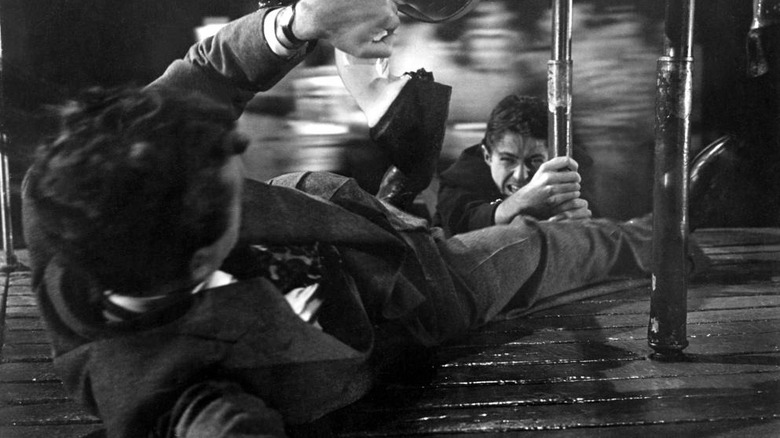Strangers On A Train Features The Most Dangerous Scene Alfred Hitchcock Ever Filmed
From "Foreign Correspondent" to "Marnie," Alfred Hitchcock always got his shot — but that doesn't mean he always kept his cool during the process. The influential British director spent much of his six-decade career dabbling in the art of suspense over some 50-odd films, so much so that he was dubbed a master of it.
So highly regarded is his work that even his lowest-ranking films, like the single-setting thriller "Lifeboat," are still lauded efforts. Hitchcock isn't too bothered with plausibility in his films, but his approach to suspense is one that's been studied in film courses for decades, summed up by the oft-repeated analogy of the bomb under the table. At a 1972 AFI Seminar roundtable, the filmmaker explains how he creates suspense for an audience:
"Four people are sitting around a table, talking about baseball or whatever you'd like. Five minutes of it. Very dull. Suddenly a bomb goes off. Blows the people to smithereens. What does the audience have? Ten seconds of shock. Now, take the same scene and tell the audience there is a bomb under that table and [it] will go off in five minutes. Well, the whole emotion of the audience is totally different, because you've given them that information."
The method can be seen throughout Hitchcock's oeuvre: The crop-dusting sequence in "North By Northwest," the creeping crows of "The Birds" gathering on a playground, or the greatest exercise in dread-building, which occurs in "Rope" as the audience watches a maid get incrementally closer and closer to uncovering a hidden dead body. Hitchcock's 1951 effort, "Strangers on a Train," contains several such sequences, including a tense tennis match and a botched attempt at breaking and entering. But one climactic moment was too intense even for its steely-eyed director, due to some risky stunt work.
'I'll never do anything like that again'
"Strangers on a Train" came about in 1951, just one year after Hitchcock's dazzling Marlene Dietrich-led noir "Stage Fright." The latter is considered one of his creative failures, but he followed up with a personal passion project: An adaptation of Patricia Highsmith's novel of the same name, with a script written first by Whitfield Cook, then "The Big Sleep" author Raymond Chandler. None of the screenplays were quite to Hitchcock's liking, and so the finalized draft was a group effort between (according to "Alfred Hitchcock: A Life in Darkness and Light") three women: Greenhorn screenwriter Czenzi Ormonde, associate producer Barbara Keon, and Alma Reville, Hitchcock's wife. Among the additions given to the story were a climax sequence featuring a knockdown, drag-out fight on an out-of-control merry-go-round. The two main leads, played by Robert Walker and Farley Granger, have finally clashed following a murder — one has failed to follow through on his deal to "swap" murders with the stranger of the title, and now a death is about to be pinned on the innocent man. The amusement park ride spins at dangerous levels, and with children aboard (gleefully having the time of their lives, it should be noted), the situation is hairy.
It's not Farley Granger's hero who saves the day, though: The savior is a hunched old man who doesn't hesitate before crawling under the massive rogue machine. In "Hitchcock/Truffaut," Hitchcock tells Francois Truffaut that the savior was not a professional stuntman nor even an actor -– he was a volunteer carousel operator.
"My hands still sweat when I think of that scene today. You know, that little man actually crawled under that spinning carousel. If he'd raised his head by an inch, he'd have been killed. I'll never do anything like that again."
The scene itself is a visual powerhouse. After the old man successfully crawls to the center and pulls the switch, the entire ride comes to a crashing halt. The scene was done with a miniature of the carousel, projected onto a screen with live actors screaming in front of it. Hitchcock, it seems, was intimately aware of what stunt-a-riffic creators like Jackie Chan, Zoe Bell, and Michael Bay have been showing us for ages: to paraphrase a quote of his from a book called "It's Only a Movie," sometimes a suspense movie is mere inches away from becoming a graphic horror movie.
